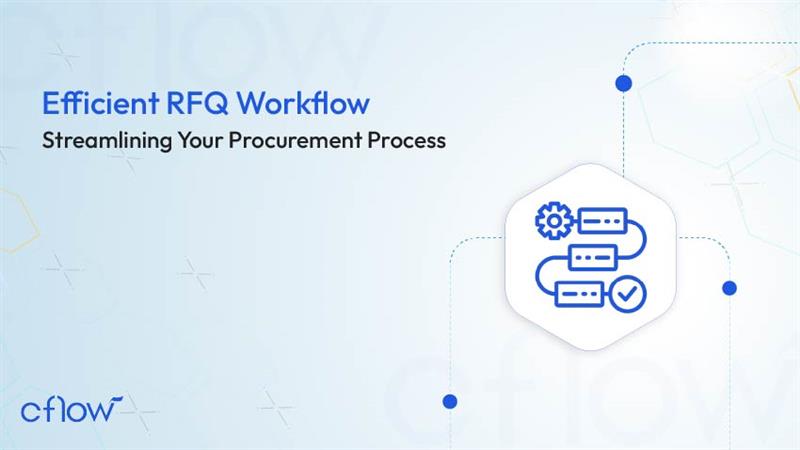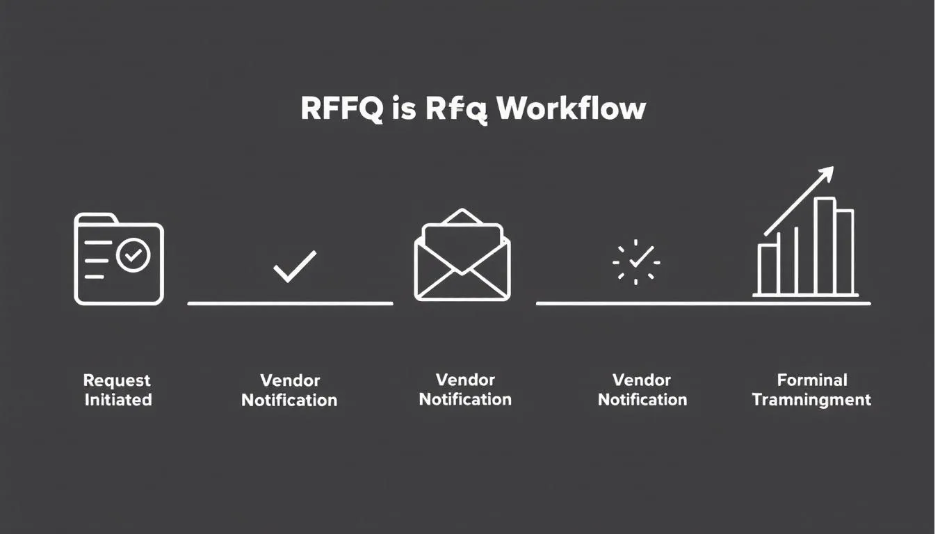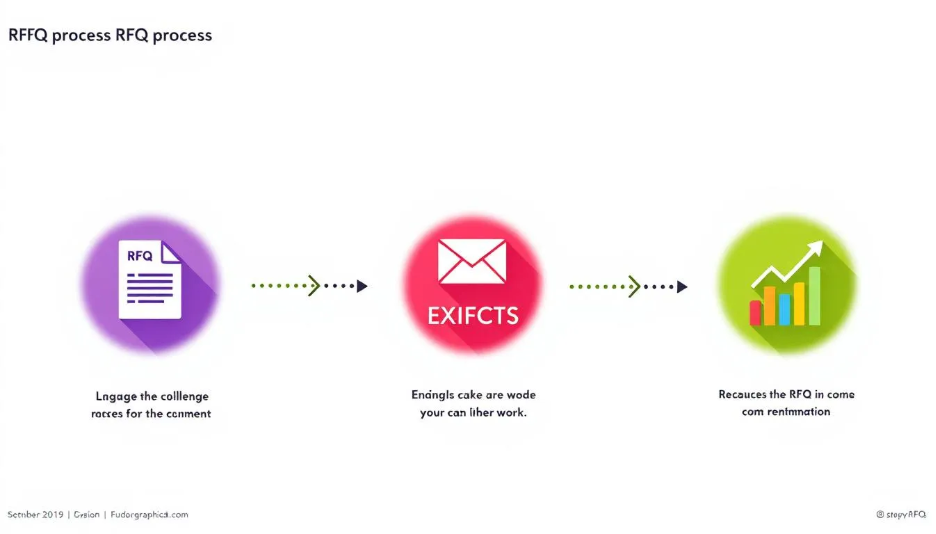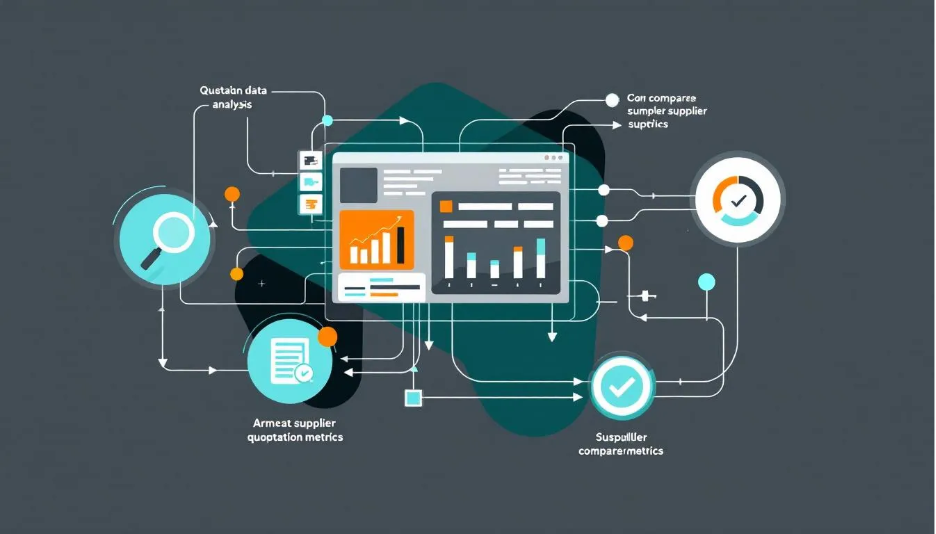Efficient RFQ Workflow: Streamlining Your Procurement Process

Key takeaways
- The RFQ process fosters competition among suppliers, ensuring transparent and fair procurement while enabling accurate price comparisons and reliable vendor selection.
- A well-prepared RFQ document, including clear specifications and standardized templates, is critical for obtaining accurate supplier quotes and facilitating informed procurement decisions.
- Leveraging technology, such as RFQ automation tools, enhances workflow efficiency, reduces errors, and improves vendor evaluation by standardizing criteria for bid comparisons.
Table of Contents
Understanding the RFQ Workflow

The RFQ process is a cornerstone of effective procurement, designed to invite suppliers to submit pricing for specific goods or services, thereby creating competition and enabling businesses to make cost-effective decisions.
At its core, an RFQ facilitates vendor offers, allowing organizations to compare options and select the best value. This competitive environment not only drives down costs but also ensures that suppliers meet the predetermined quality and performance standards.
One of the most significant advantages of the RFQ process is the transparency and fairness it brings to procurement. When all suppliers receive the same detailed information, the RFQ process promotes a level playing field, enhancing trust and fairness.
The key outcomes of an RFQ include fair competition, accurate pricing, and the ability to confidently compare costs and select trusted vendors. This structured approach not only saves time but also reduces errors, leading to a more efficient procurement workflow.
Clear requirements in an RFQ help avoid assumptions by suppliers, preventing inaccurate quotes. A well-defined RFQ document helps suppliers understand exactly what is expected, thereby facilitating accurate and competitive responses. This clarity ultimately supports better decision-making and ensures that the purchases support both quality and savings.
Preparation of the RFQ Document
A well-prepared RFQ document is the foundation of an effective RFQ process. Clearly defined buyer requirements in the RFQ document enable suppliers to submit competitive offers that meet specified needs.
Detailed RFQs with precise specifications and clear deadlines are essential for obtaining accurate supplier quotes, which in turn, facilitate better procurement decisions.
A comprehensive RFQ document should include product or service details, quantities, performance requirements, and expected quality levels. Using standardized RFQ templates can further assist organizations in procuring cost-effective products or services by ensuring consistency and simplifying the comparison of bids, as outlined in the rfq report. A request for quotation rfq can also enhance the clarity of service details.
Additionally, clear terms and conditions should be incorporated to avoid any disputes during the procurement process.
1. Define Specifications and Quality Requirements
Defining detailed specifications and quality requirements is crucial to aligning supplier proposals with the buyer’s expectations. Utilizing consistent RFQ templates that include detailed specifications can significantly improve clarity and ensure that all necessary information is captured, thereby avoiding misunderstandings and reducing the time needed for revisions.
This approach helps identify suppliers that meet specific quality standards and compliance standards, ensuring that the final purchase supports the organization’s goals.
2. Use Standardized Pricing Templates
Standardized pricing template plays a vital role in facilitating easy comparison of bids and ensuring consistency across submissions. Including a standard RFQ template simplifies the bid comparison process and enhances the comparability of different supplier bids. Additionally, it allows users to compare offers effectively.
This uniformity allows for quicker processing and reduces the chances of omissions during the procurement phase, ultimately leading to more informed purchasing decisions that save time.
3. Include Clear Terms and Conditions
Including clear terms and conditions in the RFQ document is essential to avoid disputes during the procurement process. Key components such as payment terms, delivery expectations, and warranty or service clauses should be clearly defined to ensure that both parties understand their commercial requirements and obligations in the purchase order.
This clarity reduces the likelihood of conflicts and ensures a smooth procurement process, fostering better relationships with suppliers.
4. Defining and Selecting Qualified Suppliers
Selecting the right suppliers is a critical step in the RFQ process. A robust supplier base enhances options, reduces lead times, and improves negotiation leverage, thereby supporting more effective procurement. On the other hand, having a limited number of proficient suppliers can constrain options. It can also lead to longer lead times and diminish negotiation power. Therefore, it’s essential to implement a pre-qualification process to ensure suppliers meet necessary standards of reliability before participating in the bidding process.
Manipulating the list of bidders can lead to irregularities in the RFQ process and undermine transparency. Creating a comprehensive supplier list and conducting a thorough pre-qualification process ensures organizations work with reliable vendors capable of meeting quality and performance standards. This approach not only streamlines the RFQ process but also supports fair and transparent procurement practices.
5. Create a Supplier List
Creating a supplier list involves assessing vendors who meet standards for quality, reliability, and capacity. A pre-selection event before sending an RFQ can streamline the process and limit the number of bidders, allowing for more focused evaluations.
Additionally, expanding the supplier database, exploring new vendors, and building relationships with emerging vendors can address challenges associated with a limited supplier pool, thereby enhancing the overall procurement process.
Pre-Qualification Process
The pre-qualification process is an essential step in ensuring that suppliers meet necessary standards before participating in the RFQ process. Vetting suppliers in advance ensures organizations work with reliable vendors capable of meeting quality and performance standards. This approach makes the RFQ process fair, transparent, and defensible, ultimately leading to more informed procurement decisions.
After pre-qualification, engaging these suppliers to confirm their availability and interest before distributing the RFQ request is crucial.
1. Issuing the RFQ to Suppliers

Issuing the RFQ to suppliers involves several critical steps, including the following steps to ensure a smooth and effective bidding process:
- Finalize the RFQ case, which serves as the base document for issuing the RFQ.
- Share the finalized RFQ with shortlisted vendors, including all submission instructions to facilitate accurate bidding.
- Utilize digital procurement tools to aid in RFQ distribution by reducing manual errors and keeping the workflow organized.
Contacting vendors for price quotes through email ensures that all necessary details are included, making the process efficient and transparent. After receiving quotations, documenting and acknowledging each response is crucial for creating a bid comparison sheet for analysis. This structured approach helps maintain a clear record of the RFQ status and supports better decision-making.
2. Provide Submission Instructions and Deadlines
Providing clear submitted instructions and deadlines is vital for ensuring that all suppliers understand the quoting method, including file format and deadlines. Allowing ample time to provide timelines for bidders to prepare their responses is necessary to ensure comprehensive and competitive bids.
Transparent communication regarding expectations and criteria ensures that pre-qualified suppliers can submit well-informed responses, thereby supporting a fair and efficient RFQ process.
3. Establish a Clarification Process
Establishing a clarification process during the RFQ process is essential for transparency and accurate submissions. Setting up a Q&A process allows suppliers to ask questions and receive answers, ensuring that all participants have the same detailed information. Engaging suppliers early can uncover any concerns about their capacity to fulfill the RFQ requirements, leading to more accurate and reliable bids.
This open communication fosters a collaborative environment and improves submission accuracy.
4. Receiving and Analyzing Quotations

Receiving and analyzing quotations is a critical phase in the RFQ process. The manual review of vendor bids can be time-intensive and may introduce errors or bias in decision-making. Structured RFQs accelerate decision-making without compromising on quality, helping organizations make better procurement choices. Efficiently evaluating received quotations is crucial for maintaining competitive pricing and making informed procurement decisions.
To streamline this process, it is essential to track bids and maintain confidentiality. Proper bid tracking ensures that all submissions are accounted for and prevents any unauthorized access to bid details. Additionally, evaluating bids based on selection criteria ensures that the best value is achieved by considering factors such as total cost, quality, and supplier reliability.
5. Track Bids and Maintain Confidentiality
Tracking bids and maintaining confidentiality is vital for ensuring a fair bidding process. Bids must be subject to confidentiality to protect sensitive information and maintain trust with suppliers in a sealed bid.
Closing the bidding by the due date and opening all bids immediately after ensures transparency and fairness. This approach helps prevent any bias or manipulation in the evaluation process, supporting a more equitable open bid procurement outcome.
6. Evaluate Based on Selection Criteria
Evaluating bids based on selection criteria involves assessing factors beyond just price. Terms and conditions should specify the evaluation criteria for assessing supplier responses, including:
- Total cost
- Quality
- Reliability
- Delivery performance
- Vendor responsiveness
- Financial stability
Incorporating these factors ensures create comprehensive responses evaluations.
This thorough evaluation process leads to more informed procurement decisions and better supplier relationships.
7. Selecting and Notifying the Successful Supplier
Selecting and notifying the successful supplier is the final step in the RFQ process. Documenting the RFQ process is crucial for transparency and accountability. After selecting a supplier, it’s important to:
- Document the winner
- Record process details
- Note the number of bids
- Specify the selection criteria
Establishing a clarification process can facilitate effective communication among suppliers during selection, ensuring that all parties are well-informed.
The essential criterion for selecting the successful supplier is the lowest price while meeting all selection criteria. This ensures that the chosen supplier aligns with the project’s goals and objectives, leading to a successful partnership.
8. Making the Final Decision
When making the final supplier selection, it is crucial to consider factors such as overall value, contract terms, and final pricing. The total cost of ownership should be considered to avoid higher long-term expenses and choose suppliers that offer sustainable value.
Key elements in evaluating suppliers include their overall value and final pricing, which directly affect the procurement process. Ultimately, the selected supplier should align with the project’s goals and objectives, ensuring a successful partnership.
9. Notify All Bidders
Notifying all bidders promptly is crucial for transparency in the procurement process. Professional communication helps foster trust and improve relationships with vendors for future projects. Best practices include clear communication, timely notifications, and expressing appreciation for all bidders’ efforts.
Maintaining professionalism during the email notification process can enhance future collaborations with suppliers.
Leveraging Technology for an Efficient RFQ Process

In today’s digital age, leveraging technology can significantly enhance the efficiency of the RFQ process. Implementing RFQ automation software offers several advantages:
- Digitizes workflows, minimizing manual tasks and human errors.
- Allows for real-time access to information, facilitating quicker decision-making among stakeholders.
- Enhances vendor evaluation by standardizing criteria and streamlining comparisons.
For example, platforms like Spendflo offer:
- Roll-up reports
- Dashboards
- Automated workflows These features provide visibility into work during the RFQ process. A global SaaS firm experienced a 40% reduction in procurement cycle time by utilizing such a platform.
These tools not only improve collaboration but also increase work velocity, making the RFQ process more efficient and effective.
Automation Tools
Procurement automation tools are invaluable for streamlining the RFQ process. Tools like Spendflo can enhance efficiency by simplifying tasks from supplier communication to quotation analysis. E-sourcing software can automate the Q&A process and facilitate the sharing of answers during the RFQ process, ensuring that all suppliers have access to the same information.
Hosted solutions allow other bidders to upload offers with supporting documents that were created and receive notifications, further streamlining the best solution process.
Data Security Measures
Ensuring data security during the RFQ process is crucial to protect sensitive information and maintain trust with suppliers. Implementing strict access controls and confidentiality agreements helps maintain the confidentiality of bid details.
Employing both measures fosters a secure environment, reinforcing supplier trust and ensuring the integrity of the procurement process.
End-to-end workflow automation
Build fully-customizable, no code process workflows in a jiffy.
Best Practices for Managing the RFQ Workflow

Managing the RFQ workflow effectively requires:
- Implementing structured workflows to enhance clarity and efficiency, reduce errors, and improve response times.
- Maintaining thorough documentation.
- Ensuring effective communication among team members to keep all participants well-informed and aligned.
- Utilizing digital platforms to aid in vendor selection by standardizing evaluation criteria, automating bid comparison, and ensuring transparency.
Thorough documentation of the RFQ process, including the number of bids received and the criteria used for selection, supports better vendor relationships and ensures accountability. Notifying all participating vendors after making a decision maintains professionalism and transparency, fostering trust and improving relationships with suppliers for future projects.
Standardize Templates
Standardizing RFQ documents facilitates easier comparison and evaluation of supplier bids. Using a well-structured evaluation template can significantly streamline the process of assessing vendor bids, avoiding confusion and saving time during the RFQ process.
Standardized email templates in RFQ automation help maintain consistency and clarity in supplier responses, ensuring that all necessary information is captured and easily comparable.
Evaluate Beyond Cost
Incorporating factors beyond cost in the evaluation process can lead to better procurement outcomes by ensuring quality and reliability. Key factors to evaluate beyond price include:
- Quality
- Reliability
- Supplier reputation Encouraging bidders to demonstrate their value beyond just pricing helps convey their worth and supports more informed purchasing decisions.
Final pricing should reflect not only immediate costs but also the overall value that the supplier brings to the project, including the total price.
Establish Feedback Mechanisms
Implementing structured feedback mechanisms is crucial for continuous improvement in the RFQ process. Regular feedback from suppliers can identify areas for improvement in future RFQ processes, strengthening partnerships and enhancing procurement outcomes.
A structured approach for suppliers to seek clarifications ensures that all participants receive uniform information, promoting transparency and accuracy. This continuous feedback loop fosters better communication and supports the overall efficiency of the RFQ workflow.
Conclusion
An efficient RFQ workflow is essential for modern procurement operations. By understanding the RFQ process, preparing detailed RFQ documents, defining and selecting qualified suppliers, and leveraging technology, organizations can streamline their procurement processes and achieve better outcomes. Implementing best practices, such as standardizing templates, evaluating beyond cost, and establishing feedback mechanisms, further enhances the efficiency and effectiveness of the RFQ workflow.
Ultimately, a well-structured RFQ process supports fair competition, transparency, and informed decision-making, leading to cost-effective and high-quality procurement. By adopting the strategies discussed in this guide, procurement professionals can refine their practices, foster strong vendor relationships, and drive their organizations toward greater success.
Frequently Asked Questions
1. What is the RFQ method?
The RFQ method, or request for quote, is a process where a company invites select contractors or suppliers to submit bids for specific products, projects, or services. This method is particularly valuable for businesses requiring a steady supply of standard goods.
2. What is the primary purpose of an RFQ?
The primary purpose of an RFQ is to enable companies to gather vendor offers for effective comparison, which aids in making cost-effective business decisions. This process is crucial for ensuring that organizations select the best options available.
3. Why is it important to use standardized RFQ templates?
Using standardized RFQ templates is crucial as they enable straightforward comparison of bids, ensure consistent submissions, and streamline the procurement process. This uniformity enhances efficiency and clarity in evaluating proposals.
4. How does the pre-qualification process benefit the RFQ workflow?
The pre-qualification process enhances the RFQ workflow by ensuring suppliers meet essential reliability standards, resulting in more informed procurement decisions. This ultimately fosters a more efficient and effective bidding process.
5. What role does technology play in the RFQ process?
Technology significantly streamlines the RFQ process by automating workflows, reducing manual tasks, and enabling faster decision-making. This efficiency ultimately leads to improved procurement operations.
What should you do next?
Thanks for reading till the end. Here are 3 ways we can help you automate your business:

Do better workflow automation with Cflow
Create workflows with multiple steps, parallel reviewals. auto approvals, public forms, etc. to save time and cost.

Talk to a workflow expert
Get a 30-min. free consultation with our Workflow expert to optimize your daily tasks.

Get smarter with our workflow resources
Explore our workflow automation blogs, ebooks, and other resources to master workflow automation.

